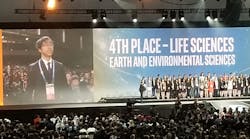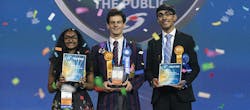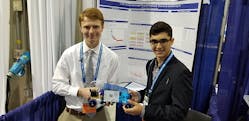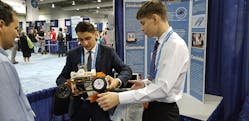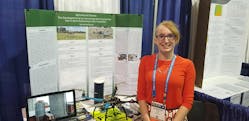I accompanied the two finalists, Sonja Michaluk and Jacob Wu, from the Mercer Science and Engineering Fair to this year’s 69th annual Intel International Science and Engineering Fair in Pittsburgh, Pa., which is run by Society for Science & the Public. Intel is the named sponsor, at least through 2019. Jacob Wu earned a 4th place in Earth and Environmental Sciences for his project "Spray and Stick: A Novel Agent for Pesticide Adhesion."
Meghana Bollimpalli, Oliver Nicholls, and Dhruvik Parikh won the top awards at the Intel ISEF 2018 (Fig. 1). Oliver Nicholls received $75,000 for the Gordon E. Moore Award. His project was “Autonomous Window Cleaning Robot for Commercial High Rise Buildings.” If you get a chance next year, you can check out the competition in Phoenix, Ariz. from May 12-17, 2019.
1. Meghana Bollimpalli, Oliver Nicholls, and Dhruvik Parikh won the top awards at the Intel ISEF 2018. (Courtesy of Society for Science & the Public/Chris Ayers)
There were a wide range of projects utilizing the latest technology like “CARL: A Convolutional Neural Network Powered Self Driving Car” (Fig. 2). Michael Hall and Daniel Ellis used a modified Google Inception v3 convolutional neural network (CNN). Their Raspberry Pi gobbled up a 160- × 90-pixel video stream at 40 frames/s.
2. Michael Hall and Daniel Ellis present their project, “CARL: A Convolutional Neural Network Powered Self Driving Car.”
Pavel Khakimov and Migran Sharoian from the Russian Federation developed a Multipurpose Platform Stabilization System (MPSS), also taking a fourth place award in Robotics and Intelligent Machines (Fig. 3). The 3D-printed construction was combined with commutator-less motors and an active independent damper system to reduce natural vibrations of the cargo platform that were detected by a vibrometer. The transportation system is designed to keep the cargo platform horizontal at all time.
3. Pavel Khakimov and Migran Sharoian from the Russian Federation developed a Multipurpose Platform Stabilization System (MPSS).
Of course, not all of the projects were about cars. Arya Eledath from Greenwood Laboratory School built a robot dog from Lego Mindstorms (Fig. 4). Guide dogs are expensive but very useful to the visually impaired. “Guide Bot: A Robotic Guide Dog” is designed as an electronic counterpart. The robot is controlled manually using a touch sensor or infrared remote, or just through voice commands. It can automatically detect and avoid obstacles, identify upcoming level changes, and inform the user like a live guide dog.
4. Built from Legos, Arya Eledath’s robot dog can assist the visually impaired.
As you might guess, 1,800 students can generate a lot of projects, so I will wrap this presentation with Samantha Boyea’s project, “Agricultural Drones: The Development of an Unmanned Aerial System for Use in Semi-Autonomous Silo Inspection” (Fig. 5). She was a second-place winner in her category and was also awarded the China Association for Science and Technology (CAST) Award.
5. Samantha Boyea’s project was “Agricultural Drones: The Development of an Unmanned Aerial System for Use in Semi-Autonomous Silo Inspection.”
Small-scale farms use silos and they’re responsible for producing 70% of food worldwide. Inspections are performed to ensure the integrity, stability, and safety of the structure, but human inspectors risk low oxygen conditions and the presence of dangerous gases such as nitrogen dioxide within the silo. That doesn’t bother her custom quadcopter, though, which was designed with a Navio 2 flight controller and Raspberry Pi.
If you can’t make it to Phoenix next year, then pop into your local science fair. Better yet, help out. We always need judges and helpers just to run the fair. Of course, students can always use your as well. Science, technology, engineering, and math (STEM) seem to always be on the minds of educators, but they often forget that competitions like this offer avenues for their students to show off their projects and expertise. Don’t forget to remind them, too.
